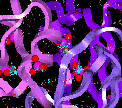 What Is a Forcefield?
What Is a Forcefield? What Is a Forcefield?
What Is a Forcefield?The fundamental computation at the core of a Discover simulation (or any other forcefield-based simulation) is the calculation of the potential energy for a given configuration of atoms. The calculation of this energy, along with its first and second derivatives with respect to the atomic coordinates, yields the information necessary for minimization, harmonic vibrational analysis, and dynamics simulations. As outlined in The Potential Energy Surface, a program such as the Discover program relies on an analytical expression of the potential energy surface in terms of a set of defined coordinates. The functional form of this expression and the parameters needed to fit the potential energy surface constitute the forcefield (Ermer 1976, Hagler 1985).
It is important to understand that the forcefield--both the functional form and the parameters themselves--represents the single largest approximation in molecular modeling. The quality of the forcefield, its applicability to the system at hand, and its ability to predict the particular properties measured in the simulation directly determine the validity of the results.
 Main
access page
Main
access page  Theory/Methodology access.
Theory/Methodology access.
 Forcefields access
Forcefields access
 Forcefields Supported by Discover Program
Forcefields Supported by Discover Program
Copyright Biosym/MSI